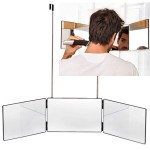Unlocking the Universe: A Comprehensive Guide to 10-Inch Mirror Telescopes
A 10-inch mirror telescope represents a significant step up for amateur astronomers, offering a compelling balance between portability and light-gathering power. These instruments open up a wealth of celestial objects for observation, from the subtle details on the surfaces of planets to the faint light from distant galaxies. This article explores the key aspects of 10-inch mirror telescopes, providing a comprehensive guide for those considering this powerful tool for astronomical exploration.
Optical Design and Performance
10-inch mirror telescopes typically employ either a Newtonian or Dobsonian reflector design. Newtonian reflectors use a parabolic primary mirror to collect and focus light onto a flat secondary mirror, which then directs the light to the eyepiece located on the side of the telescope tube. Dobsonian telescopes, a variant of the Newtonian design, utilize a simple, altazimuth mount known for its stability and affordability. The 10-inch aperture allows for significant light gathering, enabling the observation of fainter objects compared to smaller telescopes. The larger aperture also contributes to improved resolution, revealing finer details on planetary surfaces and separating close double stars.
Choosing the Right Mount
The mount plays a crucial role in the overall performance and usability of a 10-inch telescope. Dobsonian mounts are popular choices for their simplicity and affordability, making them ideal for visual observation. However, they lack the motorized tracking capabilities of equatorial mounts. Equatorial mounts compensate for the Earth's rotation, keeping celestial objects centered in the field of view, which is essential for astrophotography. For those interested in both visual observation and astrophotography, a German equatorial mount (GEM) is often preferred, but it comes at a higher cost and increased complexity.
Aperture and its Impact on Observation
The 10-inch aperture is a defining characteristic of these telescopes, significantly influencing what can be observed. This larger light-gathering area enables the observation of fainter deep-sky objects like galaxies, nebulae, and globular clusters. The increased resolving power also enhances planetary observation, revealing finer details on the surfaces of Mars, Jupiter, and Saturn. The larger aperture brings the observer closer to the faint wonders of the cosmos.
Portability and Setup
While larger than smaller telescopes, 10-inch Dobsonians are still reasonably portable. The telescope tube and mount can often be separated for transport, making it easier to move and store. Setup is typically straightforward, involving placing the tube onto the mount and making minor adjustments. Equatorial mounts can be more complex to set up, requiring polar alignment for accurate tracking.
Maintenance and Care
Proper maintenance ensures the longevity and optimal performance of a 10-inch telescope. The primary mirror will occasionally require cleaning, which should be done carefully using specialized techniques to avoid damage. Collimation, the process of aligning the mirrors, is also important for maintaining sharp focus. Regular maintenance helps preserve the telescope's optical integrity and ensures consistently clear views.
Cost Considerations
10-inch telescopes represent a mid-range investment in amateur astronomy equipment. Dobsonian telescopes are generally more affordable than those with equatorial mounts due to their simpler design. The cost can further vary based on the quality of the optics, the features of the mount, and included accessories. It's important to consider the overall budget and intended use when selecting a telescope.
Accessories for Enhancing Observation
A variety of accessories can enhance the observing experience with a 10-inch telescope. Eyepieces with different focal lengths provide varying magnifications, allowing for detailed views of planets or wider fields of view for deep-sky objects. Filters can enhance specific features of celestial objects, such as planetary nebulae or the details on Mars. A Barlow lens increases the effective focal length of the telescope, providing higher magnification.
Observing Targets for a 10-Inch Telescope
A 10-inch telescope opens up a vast array of observing targets. From the intricate details within the rings of Saturn to the faint spiral arms of distant galaxies, there is a universe of objects to explore. This aperture allows for detailed observations of planets, the Moon, nebulae, star clusters, and galaxies, offering breathtaking views of the cosmos and a deeper understanding of the universe.

Company Seven Orion Atlas 10 Equatorial Newtonian Reflecting Telescope

Gso Parabolic Primary Mirror 10 F 5

Chinese 254mm 10 Inch Newtonian Bird Jones Reflector Telescope

Bresser Messier 10 Inch Dobsonian Telescope

Company Seven Orion Atlas 10 Equatorial Newtonian Reflecting Telescope

Gso 10 Inch Dob Telescope White

Apertura Telescope 10 Inch Dobsonian High Point Scientific

Sky Watcher 10 Inch Quattro Imaging Newtonian Telescope S11220 Telescopes At

Gso 10 Inch F4 Ota Imaging Newtonion Telescope Astrophotography Reflector Telescoepe Taiwan

Dobsonian Telescope 10 Inch Gso Reflector Astronomy Made In Taiwan








